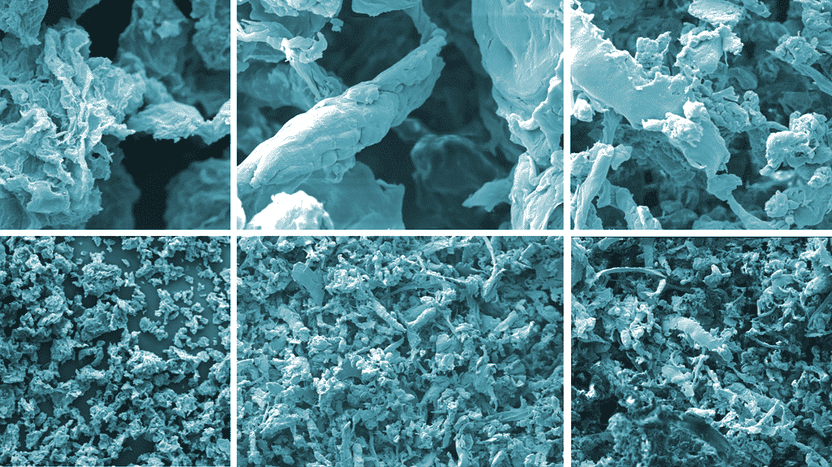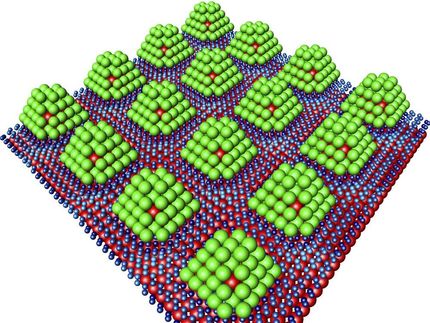Graphene dust not harmful, study finds
Analysis of health risks associated with graphene-containing particles
Graphene-based particles released from polymer composites after abrasion induce negligible health effects. Under the leadership of Empa, an international research team of the graphene Flagship project conducted a study on the health risks of graphene-containing nanoparticles and recently published the results in Journal of Hazardous Materials.

Graphene Flagship researchers analyzed the effect of particles derived from polyamide reinforced with reduced graphene oxide. Colored SEM images of abraded particles.
Empa / Journal of Hazardous Materials
Graphene-related materials (GRMs) are often used to reinforce polymers. In small concentrations of up to five weight percent, GRMs can significantly enhance the strength, electrical conductivity and thermal transport of composites for a variety of applications. However, being a relatively new set of materials, graphene and GRMs need to be carefully assessed in order to identify potential adverse effects prior commercialization.
In a new study, a large interdisciplinary team of scientists funded by the EU's Graphene Flagship project prepared a composite of polyamide 6 (PA6, also known as Nylon-6) – a thermoplastic polymer used in several sectors such as automotive and sports equipment – with 2.5 percent reduced graphene oxide (rGO), a form of graphene that enhances the reinforcement of the polymer. Then they abraded this material mimicking further processing or end-of-life scenarios, creating particles with an average diameter of 1.9 μm for rGO-PA6 or 3.2 μm with pure PA6, respectively.
Airborne materials
The researchers analyzed and compared the effects of the abraded particles consisting of either PA6-rGO, PA6 alone or pure rGO along the most likely exposure routes. Therefore, they used cell-based models representing human lungs, the gastrointestinal tract, the skin and the immune system as well as an in vivo mouse model for pulmonary exposure.
The researcher found only limited acute responses after exposure to PA6-rGO in the different cell-based models. Only rGO induced substantial adverse effects, in particular in macrophages, a type of immune cells. Since inhalation of airborne materials is a key occupational concern, the team conducted a single exposure study in mice. In agreement with the acute in vitro data, PA6-rGO induced a modest and transient pulmonary inflammation. Overall this comprehensive study suggests a likely low risk to human health at acute exposure conditions of rGO-PA6. However, further studies would be required to assess chronic effects or impact on patients suffering from chronic obstructive pulmonary disease (COPD) or asthma.
“We aim to anticipate the ‘what if?’ scenario prior to the broad use of these emerging materials to avoid future social and economic drawbacks,” says Empa scientist Peter Wick, the lead author of the study. “We anticipated questions, which will become relevant for the 'Chemicals Strategy for sustainability towards a toxic-free environment' of the European Commission, facilitating the safe and sustainable use of GRM-reinforced materials. This was only possible thanks to a multidisciplinary team of experts in polymers, graphene and nanosafety, favored by the Graphene Flagship ecosystem.”
Andrea C. Ferrari, Science and Technology Officer of the Graphene Flagship and Chair of its Management Panel, adds: “This comprehensive study of possible toxicity of graphene-polymer composite fragments highlights the central role that health and safety plays in the Graphene Flagship since its very beginning. When these composites are processed into industrial parts, one needs to seriously consider the possible health implications due to emitted/abraded particles. It is reassuring to see this study shows negligible effects, thus confirming the viability of graphene for mass applications”.
Original publication
S Chortarea, OC Kuru, W Netkueakul, M Pelin, S Keshavan, Z Song, B Ma, J Gomes, E Villaro Abalos, LA Visani de Luna, T Loret, A Fordham, M Drummond, N Kontis, G Anagnostopoulos, G Paterakis, P Cataldi, A Tubaro, C Galiotis, I Kinloch, B Fadeel, C Bussy, K Kostarelos, T Buerki-Thurnherr, M Prato, A Bianco, P Wick; Hazard Assessment of Abraded Thermoplastic Composites Reinforced with Reduced Graphene Oxide; Journal of Hazardous Materials (2022)
Original publication
S Chortarea, OC Kuru, W Netkueakul, M Pelin, S Keshavan, Z Song, B Ma, J Gomes, E Villaro Abalos, LA Visani de Luna, T Loret, A Fordham, M Drummond, N Kontis, G Anagnostopoulos, G Paterakis, P Cataldi, A Tubaro, C Galiotis, I Kinloch, B Fadeel, C Bussy, K Kostarelos, T Buerki-Thurnherr, M Prato, A Bianco, P Wick; Hazard Assessment of Abraded Thermoplastic Composites Reinforced with Reduced Graphene Oxide; Journal of Hazardous Materials (2022)
Topics
Organizations
Other news from the department science
These products might interest you

NANOPHOX CS by Sympatec
Particle size analysis in the nano range: Analyzing high concentrations with ease
Reliable results without time-consuming sample preparation

Eclipse by Wyatt Technology
FFF-MALS system for separation and characterization of macromolecules and nanoparticles
The latest and most innovative FFF system designed for highest usability, robustness and data quality

DynaPro Plate Reader III by Wyatt Technology
Screening of biopharmaceuticals and proteins with high-throughput dynamic light scattering (DLS)
Efficiently characterize your sample quality and stability from lead discovery to quality control

Get the chemical industry in your inbox
By submitting this form you agree that LUMITOS AG will send you the newsletter(s) selected above by email. Your data will not be passed on to third parties. Your data will be stored and processed in accordance with our data protection regulations. LUMITOS may contact you by email for the purpose of advertising or market and opinion surveys. You can revoke your consent at any time without giving reasons to LUMITOS AG, Ernst-Augustin-Str. 2, 12489 Berlin, Germany or by e-mail at revoke@lumitos.com with effect for the future. In addition, each email contains a link to unsubscribe from the corresponding newsletter.

























































